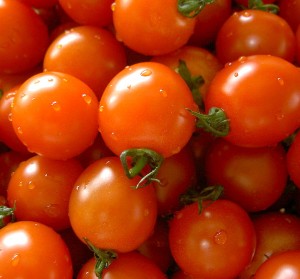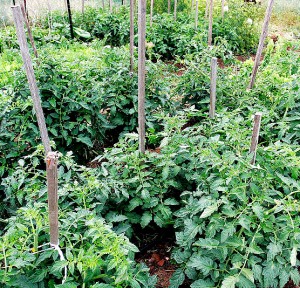 Tomato (Solanum lycopersicum), popularly known as “Kamatis” in the Philippines, is a savory, typically red, edible fruit, as well as the plant which bears it. The tomato fruit is consumed in diverse ways, including raw, as an ingredient in many dishes and sauces, and in drinks. While it is botanically a fruit, it is considered a vegetable for culinary purposes, which has caused some confusion.
Tomato (Solanum lycopersicum), popularly known as “Kamatis” in the Philippines, is a savory, typically red, edible fruit, as well as the plant which bears it. The tomato fruit is consumed in diverse ways, including raw, as an ingredient in many dishes and sauces, and in drinks. While it is botanically a fruit, it is considered a vegetable for culinary purposes, which has caused some confusion.
The tomato belongs to the nightshade family. The plants typically grow to 1–3 metres (3–10 ft) in height and have a weak, woody stem that often vines over other plants. It is a perennial, although often grown outdoors in temperate climates as an annual.
Tomato is the top source of Vitamin A and C. It also contains a significant amounts of dietary fiber, beta-carotene, iron, lycopene, magnesium, niacin, potassium, phosphorus, riboflavin and thiamine. Tomato is low in saturated fat, cholesterol and sodium. And unlike most foods, cooking or processing of tomato (e.g. tomato paste, catsup, tomato soup, tomato sauce) is beneficial to health. Heating up tomato breaks down its cell walls and releasing more lycopene, a phytochemical that is good to our health.
Tomato is one of the most important vegetable crops in the Philippines. It is grown for both home and market in almost any community in the country.
Varieties:
- Heat Resistant Tomato Tropics or Hot Season: (Xina, Formosa, Carioca, F1 Caracoli, F1 Calinago, F1 Caribou and F1 Djebel.)
- Tomato Cherry Type: ( Red Cherry and Red Pearl)
- Fresh Market for Outdoor Product: (F1 Carmine, F1 Sierra, Floradade, Calypso, F1 Sultan, Supermarmande, Saint Pierre)
- Tomato Processing Type for Industry or Fresh Market : (Roma VF, Rossol, Rio Grande, Tropimech, Heinz 1370, Ibid F1)
- Hybrid for Greenhouse: Magic F1
How to grow Tomato or Kamatis:
Soil and Climatic Requirements
The crop can be grown successfully in a wide range of soil types. For large yields, as the production of the crop for processing, silt loamy soils, clay loamy soils and loamy soils are ideal. Where the growing season is short and earliness is desired, sand or sandy loamy soils are preferred. Tomato requires warm weather and plenty of sunshine or a relatively long season to produce profitable yields.
Raising of Seedling
For backyard or school gardens, use seed boxes and for large scale field planting, use seedbeds. The seedbeds or seed boxes are prepared in the same manner as they are prepared for cabbage, cauliflower, etc. Shallow furrows, about 15 cm. apart are made across the length of the seedbeds or seed boxes with the use of bamboo slat or wood with a wedge shape on one side. The seeds are sown thinly and evenly into the shallow furrows, covered thinly with fine soil and watered. About two weeks from sowing, the developing seedlings are fertilized with a fertilizer solution prepared by dissolving 8 level tbs. Of ammonium sulfate fertilizer in 5 gal. of water. After sprinkling the fertilizer solution, the seedlings are rinsed with tap water. In 25 to 30 days from sowing, the seedlings are ready for field planting.
Land Preparation
The land is plowed and harrowed several times until a fine tilth is obtained. For heavy soils, it is best to dry the plowed land for a week and then to flash irrigated the land. As soon as the soil becomes workable, the land is harrowed and leveled. Double-furrows,
about 15 cm. deep and 50 cm. apart, are made with the use of a plow with the board removed or with a furrower. The double rows are spaces one meter apart.
Fertilization
Under many conditions, the application of 345 to 400 kg. per ha. of a 12-24-12 fertilizer mixture is suitable. The fertilizer is applied into the furrows immediately before or at planting time. When the plants start to bloom or when there are some small fruits developing on them, side dress with nitrogenous fertilizers. About 100 to 150 kg. of ammonium sulfate fertilizer per hectare would be sufficient. Side dressing should be done at bedding or banking time.
Transplanting
The seedbeds or seedboxes should be watered sufficiently before lifting the seedlings. The seedlings are set immediately after the furrows are made and the fertilizer is applied. The seedlings are set 50 cm. apart in the furrows. Water the newly transplanted seedlings. Replant all missing hills within one week from transplanting.
Cultivation, Weeding and Irrigation
About a month from transplanting, the double rows of plants are bedded or banked using a small tractor provided with a ridge or a plow. Bedding or banking provides soil mulch and thus eliminates later cultivation and weeding, and also facilitates irrigation. The frequency or irrigation depends upon the weather condition and type of soil. Light soils may require more irrigation than heavy soils. The irrigation water is allowed to pass between the bedded or banked double-rows of plant, taking care not to allow overflowing.
Control and Pests of Diseases
- Pest and Their control: The common pest of tomato is the tomato fruit worm (Helicoverpaarmigera (Hubner) Chadwich. This pest can be controlled by spraying with Sevin at the concentration of 3 to 4 leave tbs. per 5 gal. of water. The plants should be sprayed before the fruits begin to appear. Sprayingis continued at one to one and one-half week intervals. This will also control the lady beetle (Epilachna Philippinensis Dieke) commonly feeding on the leaves.
- Diseases and their Control: The most serious disease of tomato is bacterial wilt. Do not plant on lands heavily infested with the causal organisms. The other diseases of tomato are (a) Anthracnose that can be controlled by spraying with Zarlate, Dithane Z-78, or Manzate at 2 lb. per 100 gal. of water at weekly intervals; and (b) leaf mold which can be controlled by spraying with Cupravit, Zerlate or Orthocide at 2 lb. per 100 gal. of water.

Harvesting, Curing and Storing
Tomatoes are harvested or picked at several stages of maturity, depending upon how they are to be marketed or used. For distant markets, pick the green wraps, breakers and some pinks. For nearby markets or home use, pick the red- ripe fruits. Green wraps are mature fruits the color of which is still green. Pinks are characterized by the first discoloration of half of the fruit. For distant markets, the fruits are packed in boxes or baskets that are loaded in trucks. In picking, care should be taken to avoid bruising as this would cause great damage while the fruits are in transit.
Tips:
Choose tomatoes that have a deep rich color. Not only is this one of the signs of a delicious tasting tomato, but the deep color also indicates that it has a greater supply of the health-promoting phytonutrient red pigment, lycopene. Tomatoes should be well shaped and smooth skinned with no wrinkles, cracks, bruises or soft spots. They should not have a puffy appearance since this indicates that they will be of inferior flavor and will cause excess waste during preparation. Ripe tomatoes will yield to slight pressure and will have a noticeably sweet fragrance.
Since tomatoes are sensitive to cold, and it will impede their ripening process, store them at room temperature and out of direct exposure to sunlight. They will keep for up to a week, depending upon how ripe they are when purchased. To hasten the ripening process, place them in a paper bag with a banana or apple since the ethylene gas that these fruits emit will increase the tomato’s maturation. If the tomatoes begin to become overripe, but you are not yet ready to eat them, place them in the refrigerator (if possible, in the butter compartment which is a warmer area), where they will keep for one or two more days. Removing them from the refrigerator about 30 minutes before using will help them to regain their maximum flavor and juiciness.
Sources: Wikipedia.com and whfoods.com; Photos: Wikipedia.com
very informative and useful to farmers like me